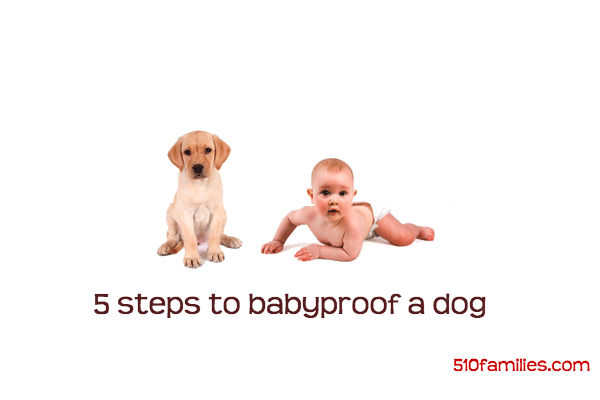My friend Laurie in Oakland is working with dog trainer Michael Wombacher, author of Good Dog, Happy Baby, to improve her dog’s behavior around her toddler. She forwarded these helpful tips from him.
You’ve put up the baby gates, you’ve locked the cabinets, and you’ve padded down all the sharp corners in your house. But have you stopped to ask if your dog is ready for a new baby in the house? Many issues with dog and baby interactions (such as a dog biting or growling at a baby) begin around the time a baby starts crawling—the same time you are babyproofing your house. That being the case, let’s take a quick look at five helpful exercises you can do to babyproof your dog, and get him or her ready to have positive interactions with children.
Step 1: First and foremost, ensure that your dog is well trained and respects you as his leader. That doesn’t mean you’re a bully, always needing to “show him who’s boss.” But it does mean that your dog should be in the habit of looking to you for direction before making important decisions and in situations of uncertainty. This way you’ll be able to guide him into new and novel circumstances, including those involving children.
Step 2: Teach your dog to accept childlike handling and never, no matter what, to bite or even mouth gently in response to being touched. In my puppy classes I teach a series of handling exercises, such as holding the puppy in your arms without allowing him to struggle, giving him a body examination while doing so, “hazing” him by batting him around, pulling an ear, a tail, poking his side, all in an upbeat tone and with the presence of lavish treats. Any biting is immediately and sharply reprimanded as the dog must learn that occasionally humans will handle you a bit roughly, but that biting is still off limits. Once your dog tolerates this sort of handling from you see if you can find some kids to do the same exercises with him. Since you’ll have already broken him in, he shouldn’t find the transition difficult. If the dog attempts to bite or mouth the kids, you reprimand him. If you’ve got an older dog who’s never done such exercises all the same rules basically apply, except that you want to take a bit more time to ease him into it. You can definitely teach an old dog new tricks; sometimes it just takes a little longer. Even if your dog is taking handling from a child like a champ, realize that it is never safe to leave a child unsupervised with a dog.
Step 3: Have as many kids as you can ask him to do commands such as sit, down and whatever else you’ve taught him in exchange for treats, all the while keeping the whole experience in a very upbeat and positive light. If your dog refuses, gently but firmly demand the behavior, teaching him that children carry at least some measure of your authority. Along the same lines, to the degree that your dog enjoys games such as fetch or favorite tricks, have as many children as want to play such games and practice such tricks with him.
Step 4: Be sure to teach your dog never to jump up on anyone, including children. There are a million ways to keep a dog from jumping: a spritz on the nose with a water bottle or a taste deterrent such as Binaca or even Bitter Apple spray; standing on the leash when the dog jumps up so that he gives himself a small correction; turning your back on the dog every time he jumps up and bending over to pet him only once he keeps all fours on the ground, etc.
Step 5:Finally, if you want your dog to spend time in an area where groups of children are playing games that the dog may not participate in, such as at the edge of a soccer field, teach your dog to hold a down-stay in those situations and offer him a long-lasting treat such as a bully stick that he can work while the games proceed without him. That way he’ll learn to associate an appropriately calm behavior with all the mayhem about him.
In closing, I would like to reiterate that to the degree your dog respects you as leader – a position earned through consistent, kind training and the willingness to provide structure, guidance and authority – to that same degree you will be able to help your dog understand how to behave towards your baby.

Michael Wombacher is an author, lecturer, and dog trainer for San Francisco Bay Area families, with over 20 years of hands-on training experience. His easy-to-understand training book, Good Dog, Happy Baby, is filled with hundreds of tips and techniques to prepare your dog for the arrival of your new baby. Learn more.
Share this:
- Click to share on Facebook (Opens in new window) Facebook
- Click to share on X (Opens in new window) X
- Click to share on Pinterest (Opens in new window) Pinterest
- More
- Click to email a link to a friend (Opens in new window) Email
- Click to share on Tumblr (Opens in new window) Tumblr
- Click to print (Opens in new window) Print
- Click to share on Reddit (Opens in new window) Reddit
- Click to share on Pocket (Opens in new window) Pocket
- Click to share on LinkedIn (Opens in new window) LinkedIn






2 thoughts on “Five steps to babyproof a dog”
Step 1 starts off by assuming the dog is mature and not a puppy, so does that mean you advise against getting a puppy while raising a small child?
Hi there,
In the event that (god forbid) something has already happened to a young one involving the dog.
What steps should be made to ensure both the safety of the dog and the child?